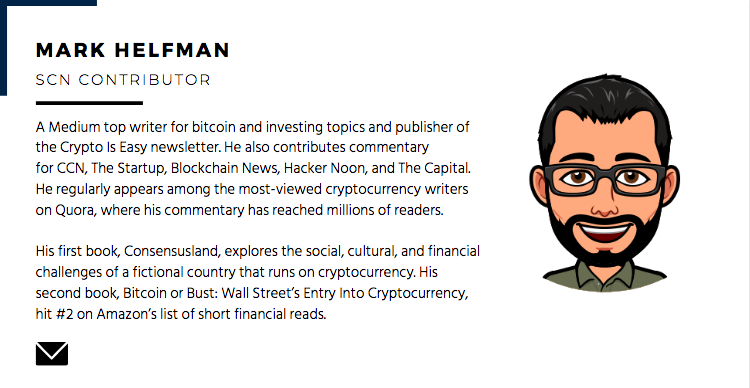
In the cryptocurrency industry, even the most seasoned professionals have less than a decade in the field. Many have only a few years.
In no other field does a few years of experience make you an expert.
Savvy? Sure.
Knowledgable? Let’s hope.
A good source of information? Yep!
Not an expert.
When you see people who have large followings or popular books, you may think they have some incredible insight that you don’t—even though they all mostly say the same thing.
For a culture that prides itself on contrarian thinking and rebelling against “the herd,” we sure do a lot of groupthink.
Why? Nobody really knows what’s going on. We all have one small piece of a massive puzzle. At best, we have some gleanings, insights, and inferences about the bigger picture.
Data models abound, but they all disagree with each other. Markets move faster than YouTube can handle. Everybody’s got their opinion.
A little skepticism goes a long way.
What makes anybody else’s opinion better than yours?
Anything is possible if you believe
For most of my twenties, I worked in Congressional politics—first as a campaign organizer, then as a Congressional aide, and later as assistant to the top lobbyist of a Fortune 500 company.
My biggest takeaway from those jobs?
No matter what the facts say, you will believe whatever you want to believe. Eventually, somebody will come along to take advantage of your beliefs.
In politics, you can make a living doing this. In fact, there’s a whole subset of the industry dedicated to this work. It’s a skill some people practice and hone for years. Those who do it well can make a lot of money as consultants, speechwriters, press aides, spokespeople, radio hosts, and commentators.
These people train their entire lives on how to turn truth into falsehood and spin facts into fiction. They learn how to use semantics, straw man arguments, and distractions to present a false narrative or keep people from the truth.
There’s a reason they make a lot of money doing this. People will buy into whatever story makes them feel good, smart, right, and safe.
Whether that story’s true or not?
It doesn’t matter.
If you believe it’s true, it’s true.
When I got into cryptocurrency in 2017, I believed a lot of stories, too. Pretty much everything the “experts” said.
At that time, they said bitcoin could never crash because CME futures would bring in tons of money and Wall Street would buy up the market.
Then bitcoin crashed, dragging the altcoins down with it.
To explain the lag on the markets for the first part of 2018, they said “Asians sold crypto to buy gifts for Chinese New Year, it’ll bounce back after the holiday.”
When prices kept falling, they said “U.S. investors are selling to pay taxes, it’ll bounce back after tax season.”
When prices still kept falling, they said “whales and Wall Street are manipulating the prices down, they can’t do this forever, it’ll bounce back.”
Once the market settled around $6,000, they said the bottom was in.
Then bitcoin’s price crashed another 50% and most altcoins dropped 90% or more.
They blamed Craig Wright, Roger Ver, governments, ICOs, scams, and whatever else they could think of.
They should’ve blamed themselves.
Seems reasonable, but is it right?
At the time, all of their arguments made sense to me. I bought into them every step of the way, up to the top and down to the bottom.
I believed.
Only later did I learn how this market really works.
In March 2020, seemingly everybody thought bitcoin would go to $1,000, “retrace to the 350-week moving average,” and “complete an A-B-C correction.” They said we’d have a new Great Depression and a collapse in all assets, including crypto. “Deflation, then inflation.”
All those things were possible. Not just possible, but reasonable expectations for anybody involved in this market at that time.
Any honest accounting of history would tell you those outcomes were unlikely. Bitcoin never stays below its 200-week moving average and at the time, on-chain metrics oozed strength.
Sure, it could’ve gone the other way. If you’d convinced yourself of that, you would’ve missed the opportunity of a lifetime.
What about today? What stories do you hear?
- Bitcoin will go to $288,000 without any major crashes because institutions will never let it crash.
- Bitcoin’s price can’t go below $40,000 because Stock-to-Flow says so.
- Corporations will never ever sell, no matter how much their investments go up in value or fall in price.
- The bull market’s ahead of schedule so prices will go twice as high for twice as long.
- The four-year cycle and all the other data models will have to get adjusted upwards because of all this FOMO, you can’t contain it. It’s a new paradigm.
- March is always a bad month for the market.
Anything’s possible, but you lose a lot of perspective when you buy into those stories.
For example, bitcoin’s price is up 32% since March 1—hardly a bad month for any asset. Corporations and institutions exist to make money, not own bitcoin. Stock-to-Flow and S2Fx allow for a very wide variance in price at any given time. Nothing goes up forever.
Think for yourself
Perhaps crypto’s thought leaders and celebrities are not as intentionally manipulative as the people who pervade our politics, but they’re no less effective—and with the same result:
You end up believing things that probably aren’t true.
I’m sure Saifedean Ammous didn’t intentionally present a historically and culturally false portrait of monetary evolution in his famous book, The Bitcoin Standard. He probably just doesn’t know about all the discoveries historians, psychologists, and anthropologists have made about the human relationship with money and its uses over time.
Or, perhaps he dismissed them. As an Austrian economist, he’s trained in dogma and orthodoxy. Maybe he doesn’t accept ideas that contradict his worldview?
The narrative sells. It’s a good story that makes sense.
Crypto is full of good stories that make sense.
That doesn’t mean those stories are true.
Maybe it’s ok to discover your own stories?



